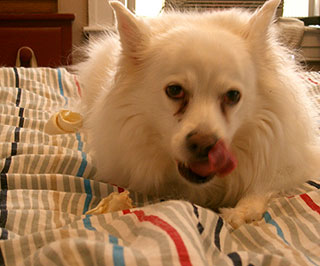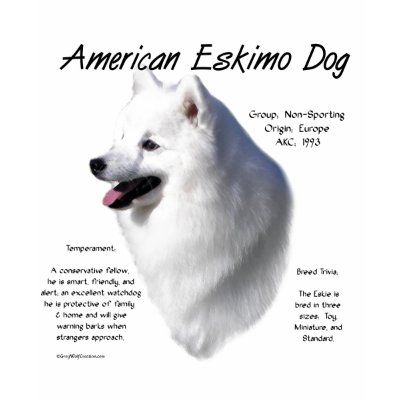The American Eskimo Dog is a small to medium sized breed of dogs of the Spitz type, originating in Germany, and is one of the most ancient of the dog families, dating back almost 6,000 years. Originally the Standard German Spitz. Its closest relatives are the other German spitzes such as the Pomeranian. The American Eskimo Dog is a house dog, companion, and watch dog.
Appearance
The Eskie is built along classic Nordic lines, a form that has proved effective at pulling heavy loads through snow and ice. It is compactly built, slightly longer than tall. The stand-off, double coat resists soaking and provides insulation against the cold. The small thick ears are also cold-resistant. The breed's smaller size has moved it from the realm of sled dog, but it remains a sled dog in miniature. The American Eskimo Dog stands furry with erect ears and a long tail curling over its back.
There are 3 separate size divisions in the American Eskimo Dog breed recognized by the American Kennel Club and the Canadian Kennel Club.
* Toy, 9–12 in (23–30 cm) at the withers
* Miniature, 12–15 in (30–38 cm) (most popular)
* Standard, 15–19 in (38–48 cm)
Dogs over 19 inches or under 9 inches are disqualified at breed shows in the US and Canada, in order to discourage the breeding of oversize or excessively small dogs. The United Kennel Club in the US does not recognize the Toy variety.
There are 3 separate size divisions in the American Eskimo Dog breed recognized by the American Kennel Club and the Canadian Kennel Club.
* Toy, 9–12 in (23–30 cm) at the withers
* Miniature, 12–15 in (30–38 cm) (most popular)
* Standard, 15–19 in (38–48 cm)
Dogs over 19 inches or under 9 inches are disqualified at breed shows in the US and Canada, in order to discourage the breeding of oversize or excessively small dogs. The United Kennel Club in the US does not recognize the Toy variety.
History
 The American Eskimo Dog "is a modern variation of a very ancient family of dogs." Spitz type dogs developed in Arctic and northern areas of the world, with the larger types being used as sled dogs.But the Eskie was specifically bred to guard people and property and, therefore, is territorial by nature and an excellent watch dog. He is very loyal to his family and is known for being gentle and playful with children. He is energetic, alert and highly intelligent. In Northern Europe, smaller Spitz were kept primarily as pets and watchdogs, and eventually were developed into the various German Spitz breeds. European immigrants brought their Spitz pets with them to the United States, especially New York, in the early 1900s, "all of them descended from the larger German Spitz, the Keeshond, the white Pomeranian, and the Italian Spitz, the Volpino Italiano."
The American Eskimo Dog "is a modern variation of a very ancient family of dogs." Spitz type dogs developed in Arctic and northern areas of the world, with the larger types being used as sled dogs.But the Eskie was specifically bred to guard people and property and, therefore, is territorial by nature and an excellent watch dog. He is very loyal to his family and is known for being gentle and playful with children. He is energetic, alert and highly intelligent. In Northern Europe, smaller Spitz were kept primarily as pets and watchdogs, and eventually were developed into the various German Spitz breeds. European immigrants brought their Spitz pets with them to the United States, especially New York, in the early 1900s, "all of them descended from the larger German Spitz, the Keeshond, the white Pomeranian, and the Italian Spitz, the Volpino Italiano."Although white was not always a recognized color in the various German Spitz breeds, it was generally the preferred color in the US. In a display of patriotism in the era around World War I, dog owners began referring to their pets as American Spitz rather than German Spitz. This name change was similar to the use in the United States of the term Freedom fries rather than French fries to refer to a popular potato dish during disputes between France and the United States before the 2003 invasion of Iraq.
After World War I, the small Spitz dogs came to the attention of the American public when the dogs became popular entertainers in the American circus. In 1917, the Cooper Brother's Railroad Circus featured the dogs. A dog named Stout's Pal Pierre was famous for walking a tightrope with the Barnum and Bailey Circus in the 1930s. Due to the popularity of the circus dogs, many of today's American Eskimo Dogs can trace their lineage back to these circus dogs.
After World War II, the dogs continued to be popular pets. Postwar contact with Japan led to importation into the United States of the Japanese Spitz, which may have been crossed into the breed at this time. The breed was first officially recognized as the "American Eskimo" as early as 1919 by the American United Kennel Club (UKC), and the first written record and history of the breed was printed in 1958 by the UKC.[9] At that time there was no official breed club and no breed standard, and dogs were accepted for registration as single dogs, based on appearance. In 1970 the National American Eskimo Dog Association (NAEDA) was founded, and single dog registrations ceased.
After World War II, the dogs continued to be popular pets. Postwar contact with Japan led to importation into the United States of the Japanese Spitz, which may have been crossed into the breed at this time. The breed was first officially recognized as the "American Eskimo" as early as 1919 by the American United Kennel Club (UKC), and the first written record and history of the breed was printed in 1958 by the UKC.[9] At that time there was no official breed club and no breed standard, and dogs were accepted for registration as single dogs, based on appearance. In 1970 the National American Eskimo Dog Association (NAEDA) was founded, and single dog registrations ceased.
In 1985 the American Eskimo Dog Club of America (AEDCA) was formed by fanciers who wished to register the breed with the American Kennel Club (AKC). Following the AKC's requirements for breed recognition, the AEDCA collected the pedigree information from 1,750 dogs that now form the basis of the AKC recognized breed, which is called the American Eskimo Dog. The breed was recognized by the American Kennel Club in 1995. The stud book was opened from 2000 to 2003 in an attempt to register more of the original UKC registered lines, and today many American Eskimo Dogs are dual-registered with both American kennel clubs. The breed is also recognized by the Canadian Kennel Club as of 2006, but is not recognized elsewhere in the world.
The American Eskimo Dog is not an internationally recognized breed, and since neither of the American kennel clubs are affiliated with the Fédération Cynologique Internationale, fanciers wishing to participate in international dog shows will register their American Eskimo Dogs as the very similar German Spitz. This is done only by individuals wishing to participate in dog sports in international shows, and does not mean that the American Eskimo Dog and the German Spitz are the same. The breeds may have the same general origins, but have developed differently over the past 100 years.
The American Eskimo Dog is not an internationally recognized breed, and since neither of the American kennel clubs are affiliated with the Fédération Cynologique Internationale, fanciers wishing to participate in international dog shows will register their American Eskimo Dogs as the very similar German Spitz. This is done only by individuals wishing to participate in dog sports in international shows, and does not mean that the American Eskimo Dog and the German Spitz are the same. The breeds may have the same general origins, but have developed differently over the past 100 years.
Health
Health testing should be performed by all responsible breeders and anyone purchasing a puppy should be aware of the genetic problems which have been found in some individuals of the breed, such as PRA (Progressive Retinal Atrophy), luxating patella, and hip dysplasia. None of these are common and the breed is generally healthy.
In addition to the problems above, the breed can have a tendency towards allergies and tear-staining, and the propensity towards these traits is inherited.
In addition to the problems above, the breed can have a tendency towards allergies and tear-staining, and the propensity towards these traits is inherited.
Temperament
American Eskimo Dogs along with other Spitz were bred to be house dogs and companion dogs, and thrive on being a part of a human family. The Eskie is highly intelligent, eager to please, very active, has lots of energy, and moderately independent. At home, these lively dogs make excellent watchdogs, barking to announce the presence of strangers. The Eskie can be protective of its home and family, but in general they will not threaten to attack or bite a person unless provoked. As with all dogs, behavior is partially inherited and partially trained. Some dogs are prone to excessive barking and separation anxiety. It is important for puppy buyers to research pedigrees as temperament may vary due to inheritance.
Grooming and training
Eskie's double coat needs brushing and combing twice weekly, more often when their biannual shedding occurs. An undercoat rake, a tool available at most pet stores, is useful for brushing out the heavy undercoat. Some owners in hot climates do shave their Eskies, but if this is done, the dogs should be kept indoors as much as possible to prevent sunburn. The breed's shedding, along with its active temperament, results in some dogs being taken to animal shelters or otherwise put up for adoption. Owners should contact breed-specific rescue groups that will give advice on grooming, training or curbing behavioral issues.
American Eskimo Dogs are very energetic and require daily exercise, the extent of the workout depending on the size of the dog. Owners can avoid problems by socializing their Eskie through obedience training or participating in dog sports, such as dog agility, flyball, and dancing.
American Eskimo Dogs are very energetic and require daily exercise, the extent of the workout depending on the size of the dog. Owners can avoid problems by socializing their Eskie through obedience training or participating in dog sports, such as dog agility, flyball, and dancing.




No comments:
Post a Comment